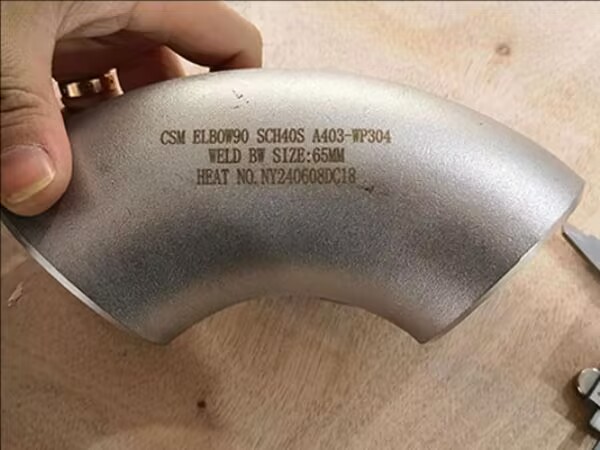In modern industrial and civil fields, pipeline systems transport water, gas, oil, chemical media, etc. like blood vessels. Stainless steel pipe
elbows, as key steering components, not only have to withstand harsh working conditions such as high pressure, high temperature and strong corrosion, but also ensure the smooth transportation of fluids and safe use. This article will introduce stainless steel elbows to you from aspects such as concept, classification, materials, manufacturing process, technical standards and application advantages.
What is a stainless steel pipe elbow?
Stainless steel pipe elbows are pipe fittings used to change the direction of pipes, and their core function is to achieve a smooth transition of the converted Angle in the pipeline. The common angles are 45°, 90° and 180°, corresponding to slight deflection, right-angle turn and backflow cycle respectively. Due to the excellent corrosion resistance and strength of stainless steel, elbows are widely used in the fields of chemical engineering, petrochemicals, power, food, medicine, etc.

Stainless steel elbows can be classified into various types. The main classification methods are as follows:
According to the manufacturing process
Seamless elbow: Formed by integral drawing, with a smooth surface and excellent pressure resistance, it is commonly used in high-pressure and high-temperature pipelines.
Butt-welded elbows: Semi-finished forgings or plates are welded and then heat-treated. They feature precise dimensions and high weld strength, making them suitable for medium and high-pressure applications.
Welded elbows (pipe elbows) : They are made by bending ordinary welded pipes with a pipe welding machine. They have a relatively low cost and are mostly used in general industrial and civil pipelines.
2. According to the bending radius
Long-radius elbow (LR) : The bending radius is approximately 1.5 times the outer diameter of the pipe, with low flow resistance and smooth fluid transition.
Short-radius elbow (SR) : The bending radius is approximately 1.0 times the outer diameter of the pipe, occupying less space and is suitable for pipelines with limited space.
3. Bend the Angle
45° elbow: Slightly change direction to reduce flow resistance and slightly increase.
90° elbow: The most common right-angle steering element.
180° elbow (U-shaped) : Achieves complete recirculation or cyclic reversing.
Commonly used materials and grades
304/1.4301: A commonly used austenitic stainless steel, it is resistant to corrosion by general media and offers high cost performance.
316/1.4401: It contains molybdenum to enhance resistance to chloride corrosion and is suitable for Marine and chemical environments.
316L / 1.4404: Low-carbon version 316, which can better prevent intergranular corrosion after welding.
2205 duplex stainless steel: Combining the advantages of austenitic and ferritic, it has high strength and resistance to stress corrosion cracking.
Key points of manufacturing process
Blanking and forming
Seamless drawing: After cutting from round steel or seamless tubes, the shape is directly drawn through a die.
Plate welding: The rolled plates are welded together to form semi-finished elbow products, which are then bent by a pipe bender.
Heat treatment
Butt-welded elbows need solution treatment (1040℃ to 1150℃) to homogenize the crystal phase and restore the corrosion resistance.
Finishing and inspection
Polishing treatment: Enhance the smoothness of both inner and outer surfaces and reduce the adhesion of impurities.
Non-destructive testing (NDT) : X-ray or ultrasonic flaw detection is used to ensure there are no cracks, pores, incomplete penetration or other defects.
Dimensional inspection: Strictly check key parameters such as the distance between the centers of bending, angles, wall thickness and outer diameter.
Main technical standards:
ASME: Standard numbers B16.9, B16.11, applicable to American standard butt-weld and socket-weld elbows.
DIN: Standard number 2605, applicable to German standard butt-welded elbows.
EN: Standard number 10253, applicable scope: European standard butt welding, socket welding and threaded pipe fittings.
Typical application scenarios
Petrochemical industry: Conveying high-temperature, high-pressure and corrosive media;
Power industry: Boiler feed water, cooling circulation system;
Food and medicine: High cleanliness polished surface, meeting hygiene standards;
Seawater desalination and water treatment: Resistant to salt spray corrosion, long service life operation;
Papermaking and environmental protection: Resistant to chemical erosion, ensuring system stability.
Conclusion
Although stainless steel elbows are small pipe fittings, they play a crucial role as "steering wheels" in pipeline systems. From manufacturing processes to material selection, and then to standard specifications and application scenarios, every step is related to the safety, lifespan and economy of the pipeline.
